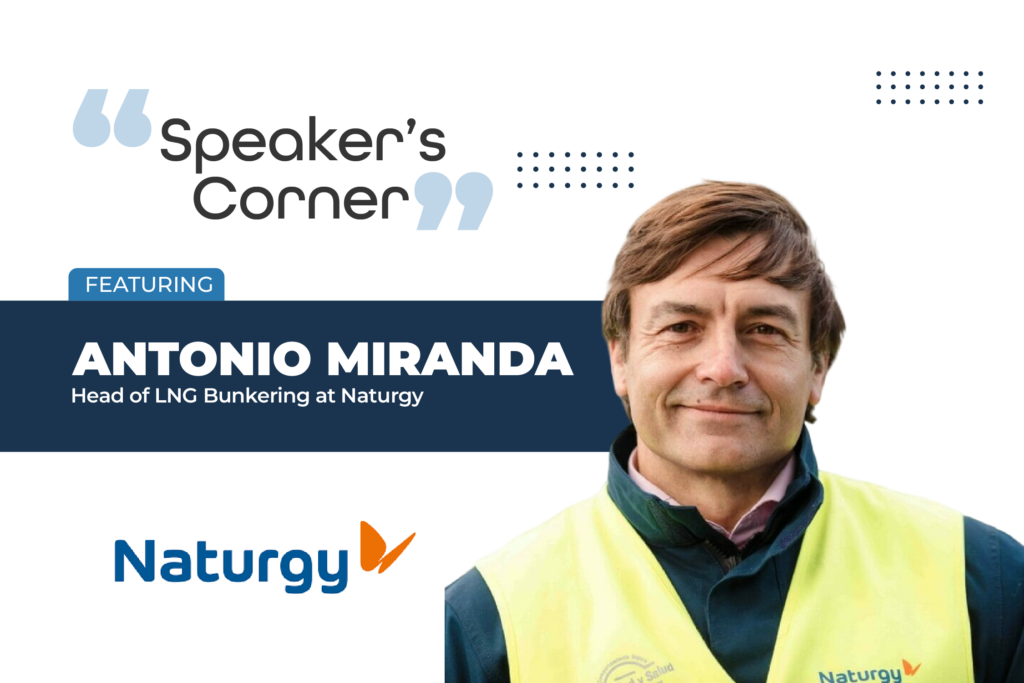
Antonio Miranda boasts 23 years of experience in the energy sector. Since June 2018, he has dedicated his career to Gas Natural Fenosa, now known as Naturgy. Throughout his journey, he has traversed various domains within the company, starting with international operations. He has navigated the retail electricity and gas markets, initially focusing on consumer segments and later specializing in large accounts. Presently, he holds the esteemed position of Head of Bunkering.
Beyond his corporate responsibilities, Antonio serves as the President of the Bunkering Working Group at SEDIGAS, showcasing his leadership and expertise in the field. Additionally, he actively contributes to the community as the President of Rugby Club Valencia and has previously held the esteemed role of Past President of the Association of Energy Engineers Spain Chapter. Antonio also serves as a board member for the CMVP, further demonstrating his commitment to professional excellence and industry advancement.
In his interview with Eventible, he discusses his experience in the LNG industry, insights into the environmental benefits of LNG as a marine fuel, and his speaking experience at America’s Energy Summit & Exhibition, among other things.
- Can you provide an overview of your experience in the LNG industry and how it led you to your current role at Naturgy?
It might come as a surprise that my background is in Energy Efficiency, not oil and gas. But since maritime companies are on a challenging path towards decarbonization, shipowners must do more with less. In this current scenario, introducing LNG and other alternative fuels is paramount. - How do you see this sector evolving in the coming years?
Digitalization, green corridors, energy efficiency, and alternative marine fuels such as LNG will be the only solutions to meet the current ambitious targets set by IMO and Repower EU. In the coming years, I foresee a completely new fleet of vessels that will be more efficient and run on today’s unknown marine fuels. Bunkering specifications, procedures, and professionals involved in bunkering operations will evolve accordingly. - What strategies has Naturgy employed to stay competitive in the LNG bunkering market, and what sets it apart from other industry players?
Naturgy has been operating in the LNG field for more than half a century now, being the leading natural gas company in Spain. We are taking advantage of all that expertise to make LNG trucks head for the ports instead of using traditional industrial facilities. Biomethane production and bioLNG are also highly valuable assets for Naturgy. We are involved in nearly one hundred biofuels projects, which will run on the same LNG infrastructure that we are using today and will help maritime companies meet their decarbonization targets. - Can you share some insights into the environmental benefits of LNG as a marine fuel compared to traditional alternatives and how Naturgy promotes sustainability in its operations?
LNG was introduced into the maritime sector in 2020 as a solution to eliminating sulfur emissions. Not only that, but LNG also reduces 85% of NOx emissions and particular matters. Besides, there is also a 20% to 30% reduction in CO2 emissions by using LNG. However, this percentage of savings will soon need to be higher.
Environmental restrictions are tough for maritime companies, and deep investments in retrofits and new construction will be required. Introducing LNG as a marine fuel will allow shipowners to meet legal constraints until 2030. The blending with bioLNG and eLNG will allow these companies to comply until 2040 and beyond. Collaboration is often crucial in the LNG industry. - How does Naturgy approach partnerships and alliances to foster growth and innovation in LNG bunkering?
Naturgy is leading several estate-founded R&D projects focused on operational considerations around bunkering operations at the port. None of them would have been possible without the collaboration of a powerful consortium. Naturgy has teamed up with logistic companies, shipowners, port authorities, and universities in a win-win project. I can assure you that you learn at least as much as you share.
Naturgy is grateful to these companies operating in the LNG bunkering field for their generosity. We all grew out of those experiences and contributed to consolidating LNG as a safe and reliable alternative fuel at the port, not to mention the key role played by gas associations. - What challenges or efforts do you anticipate will shape the future of LNG bunkering, and how is Naturgy preparing for these changes?
LNG’s challenges are well-defined. We need to reduce and accurately estimate the methane slip on board. Engine manufacturers are continuously improving their designs to lower these levels. Besides, there is an urgent need for BIOLNG. Biomethane production is still so scarce that liquefying and bunkering it is unlikely. The same is true for eLNG, where upcoming hydrogen projects are expected to lead to its synthetic production. Let’s consider that all the LNG infrastructure is ready and waiting for the same CH4 molecule of a different origin. - In your opinion, what are the main barriers or challenges hindering the wider adoption of LNG as a marine fuel, and how can the industry address them?
I would state that there is an agreement in the LNG industry admitting that we have not done enough when it comes to communication. We must make an effort to let stakeholders know LNG’s properties, advantages, and limits in its usage. If we check LNG industry records, we can say that LNG is safe, reliable, and mature enough to be considered a cost-effective solution. Introducing LNG into the maritime sector brings altogether different benefits, but unfortunately, only the players involved get to know them. - How was your experience at America’s Energy Summit & Exhibition, and what was your biggest takeaway from the event?
I learned a lot, honestly. Many skilled professionals sharing their own experiences on the field represented a valuable opportunity for the audience. It was a relief to get to know firsthand the huge capacity of LNG production in the US now and in the coming years. Not surprisingly, biofuels were not once mentioned. Different countries live in dissimilar scenarios. Europe, for example, contains a significant number of countries with little or no natural gas production, hence relying on LNG imports. - As someone with extensive experience in LNG bunkering, what advice would you offer to aspiring professionals considering entering this field?
Energy Efficiency and renewal energy are the most challenging fields of expertise nowadays. If you are considering entering the world of bunkering, you will find the same challenges we did. New alternative fuels are to come. Some are cryogenic, some need blending, and some introduce toxicity. Overall, bunkering operations will be completely different from what we know today.




Comments are closed.